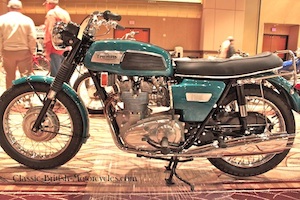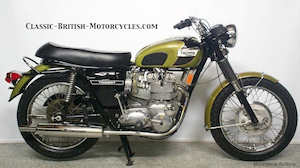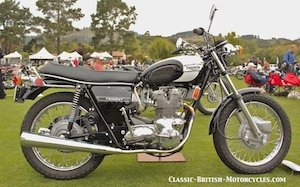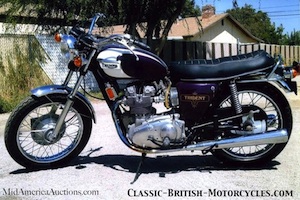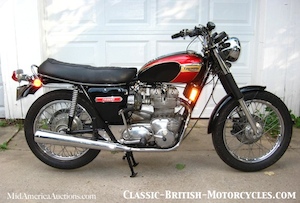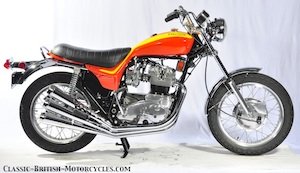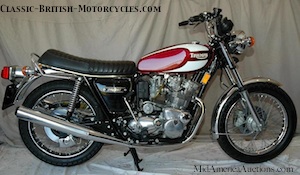The story of the Triumph Trident and her sister-bike, the BSA Rocket 3, is one of the most interesting, and at the same time most exasperating, tales in all the annals of Classic British Motorcycles. Interesting because the Triumph Trident might actually have been one of the few instances in which Triumph’s parent company, BSA, could have actually been ahead of the curve with its planning. Exasperating because it took so many years to get from concept to prototype, then prototype to production, that the window of opportunity had closed. Now instead of an incomparably fast, radically new machine, by the time it launched in late 1968 (as a 1969 model), it had already been eclipsed by the world-beating Honda 750 Four.
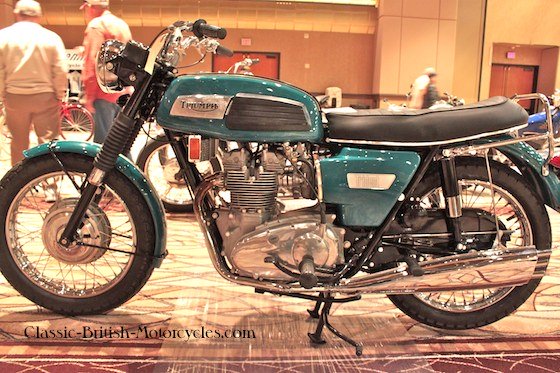
ABOVE: As introduced in 1969, the Trident came with a “Shoebox” gas tank, enormous side covers, and those laughable “Ray Gun” mufflers. Needless to say, sales suffered for it. Many people bought them like this then quickly converted them over to more conventional-looking Bonneville-style bodywork, so much so that finding an unmolested original like this is rare.
BIRTH OF THE TRIPLE
As development work commenced on the soon-to-be-released unit construction twins, veteran engineers Herbert (Bert) Hopwood & Doug Hele saw the handwriting on the wall. As good as the 650 twin was, it was already reaching its limits of performance & durability, and they were about to make it even faster! Vibration had become a problem as soon as they punched out the old 500cc Tiger T100 to create the 650cc 1950 Triumph 6T Thunderbird. It had gotten steadily worse as performance grew throughout the 1950s. The TR6 with its Delta head in 1956, followed by the twin-carb Bonneville in 1959 just made matters worse. Now that they were about to reintroduce the engine in unit-construction form, the goal was, of course, to extract even more power from it, to feed the hungry US market.
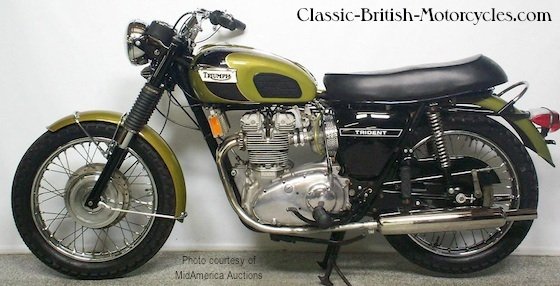
ABOVE: This is a ’69 Trident with conventional Bonneville-style bodywork, often dealer-installed. By 1970 the factory was building them all like this.
SOMETHING TOTALLY DIFFERENT
These talented designers came up a radical new idea. Instead of trying to balance a powerful big twin with a 360-degree crank, what if they split it between THREE cylinders, and arrayed the crankshaft with pins at every 120-degrees? In 1961, there were plenty of singles & twins, and even a few fours. But NO ONE had a triple! The idea was wild, especially considering the conservative nature of BSA & Triumph management at the time. But, by 1962 they had drawn up all the engine internals & by 1965 they had a running prototype engine in a 650 Bonneville frame.
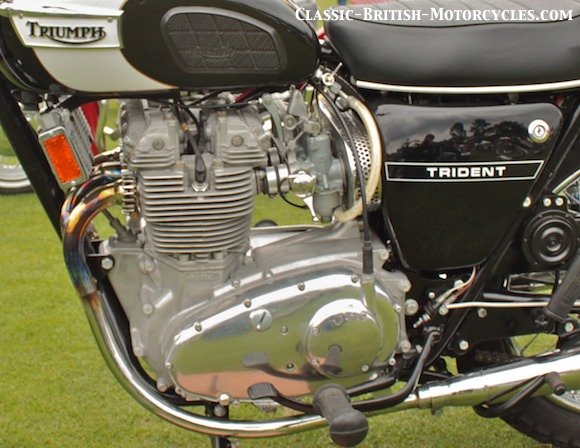
ABOVE: The Trident engine used a complicated 3-piece vertically-split crank case that was fussy to assemble and prone to leak, as did the pushrod tubes and rocker boxes, just as on the twins. But golly, what a gorgeous engine! Exotic-looking even now, imagine in 1970.
HERE’S WHERE IT GOES SOUTH
Imagine, if you will, a Triumph Trident 750 Triple in 1966. What sort of impact would it have made in a marketplace filled with British 650 twins & a few 350s & a 450 twin out of Japan? Talk about being ahead of the curve! Triumph would have had a bonafide hit on their hands & could have firmly established themselves as the preeminent performance brand. As it was, it was the fastest motorcycle in the world when it came out in 1968, even faster than the first Honda 750/4’s. Imagine that kind of performance 2 years ahead of the big Honda.
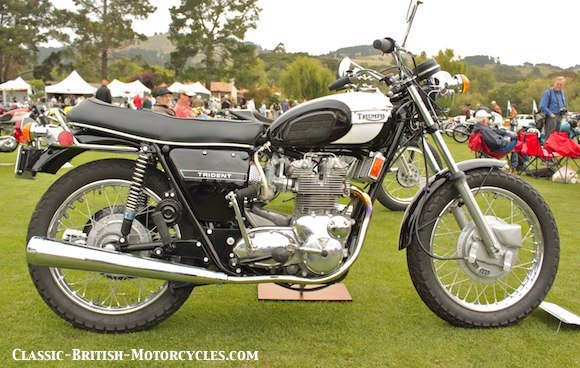
ABOVE: This lovely 1971 Trident shows how the T150 benefitted from the new hardware introduced on the 1971 Bonneville with the oil-bearing frame. This includes conical hubs front and rear, the new forks and shocks, headlight and gauge package, mufflers and bodywork. A very handsome machine, indeed.
INTERNAL SQUABBLING
Well…it didn’t happen. Endless dithering on parent-company BSA’s part caused the project to run on indefinitely until the news of the impending release of the Honda 750/4 forced them into hasty action. You would think that after several years of tinkering with the bike prior to this, that they would have had something ready for market. But alas, not even close. First off, BSA was feeling slighted by Triumph’s popularity & success, and they wanted to do something for their dealers as well. So, the insisted that the new Triumph Trident triple also be made as a BSA, to be named the Rocket 3 (presumably to honor all those great pre-unit Rocket twins). But this wasn’t going to be some badge-engineered clone of the Trident. No, that would have made too much sense. Instead, they took all the basic internals, put them into an entirely new set of engine cases whose only purpose was to provide a 15-degree slant to the cylinders, to make it look different than the Triumph, which had vertical cylinders. But that wasn’t all. They dropped it into an entirely new frame, completely different than than the Trident unit. This ridiculous maneuvering slowed introduction even more & drove up costs.
AS IF THAT WEREN’T ENOUGH…
But BSA management wasn’t done screwing up the Triumph Trident yet, or their own BSA Rocket 3, for that matter. Because they had come to the conclusion that this exciting new Triumph must not look anything like the highly successful Triumph twins. So, they subcontracted-out the styling of the bike to a firm that had never styled a motorcycle before. The Ogle company had built their reputation in industrial design, & particularly in the automotive business, having styled the Reliant Robin, among others. This further delayed the release & the final product was anything but beautiful. The new-for-1968 Triumph Trident & and BSA Rocket 3 hit the market with a clunky fuel tank so square that it became known as the “shoebox tank”, along with slab-like side covers & mufflers (silencers) so outlandish they were nicknamed “Flash Gordon” or “Ray Gun” mufflers. Funny thing: they worked better than anything that came after.
STYLING MISSES THE MARK
The radical styling simply didn’t do the bike justice & was roundly disliked by many. Styling can make or break a product & good styling doesn’t have to cost any more than poor styling. But it cost the Triumph Trident & the BSA Rocket 3 a great many sales in the critical early days, when they needed to be gaining market acceptance. By the time they got the styling right, 1971 for the Triumph Trident, it was too late & the window of opportunity had closed. The Honda 750/4 was stealing the limelight & the sales. In a desperate attempt to correct this blunder, Triumph came out with a dress-up kit that was sold through dealers & could be dealer-installed or installed by the owner, that went a long way toward fixing the horrid styling. It included a new teardrop tank (in typical Triumph style), new convex side covers & a new set of conventional mufflers (silencers). While many kits were sold, it didn’t do much to shore up the weak sales of the Triumph Trident.
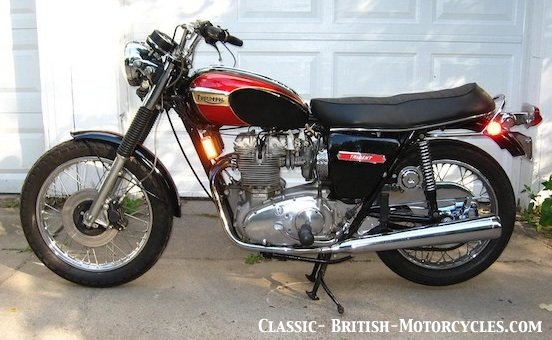
ABOVE: 1973 was a watershed year for the Trident with a long-awaited front disk brake and 5-speed gearbox.
TRIDENT EVOLUTION
T150 Trident genealogy can be broken down into 2-year chunks, with significant changes made with each, followed by the ’75 T160 Trident and then…oblivion.
1969-1970 T150 TRIDENT
The 1969 and 1970 T150 Trident were essentially the same bike other than the clunky bodywork that came on the early ’69s. They were based upon the prevalent Triumphhardware of the time, ie: 8-inch TLS front brake, 7-inch SLS rear, enclosed steel forks, brazed-lug frame.
1971-1972 T150 TRIDENT
The 1971 and 1972 T150 adopted the more modern-looking bodywork and cycle gear from the new Oil-in-Frame Bonneville and TR6 lines launched in 1971. These included those gorgeous new conical hubs front and rear, the new front forks and rear shocks, the new headlight and mounting, the new gauge package and more. The new look truly transformed the bike, giving it a much more modern air. The 8-inch conical TLS front brakes on the ’71 were weak due to poor geometry on their actuator arms, remedied by ’72. Staring in 1972, some 5-speed gearboxes were available as an option. The Trident did not get an oil-bearing frame like the twins.
1973-1974 T150V TRIDENT
The next major change came with the 1973 and 1974 T150V, with addition of a much-needed hydraulic front disk brake and the long-awaited 5-speed gearbox, which is what the “V” stands for in the model designation. Styling was cleaned up also, in keeping with the Bonneville line. The worker strike the closed the Meriden plant and crippled the company occurred early in 1974, cutting ’74 Bonneville and TR7 to a trickle. But Tridents were built in BSA‘s Small Heath factory alongside their Rocket 3, so production went on unabated. Of course, by this time, Triumph had ceased to exist as a company, along with parent company BSA, replaced by the worker-owned Meriden Co-op who were strapped for cash from the very start. They often didn’t have enough money to pay for the parts needed to finish a shipment of bikes, bikes didn’t get shipped, orders didn’t get filled, the money from those sales didn’t come in, and the Co-op’s situation worsened by the day. So, even though they were free to build Tridents at Small Heath, unfettered by the worker lockdown, they had neither the money to build them nor the customers to sell them to. Despite all this, the scrappy Triumph boys had one more trick up their sleeves for the Trident.
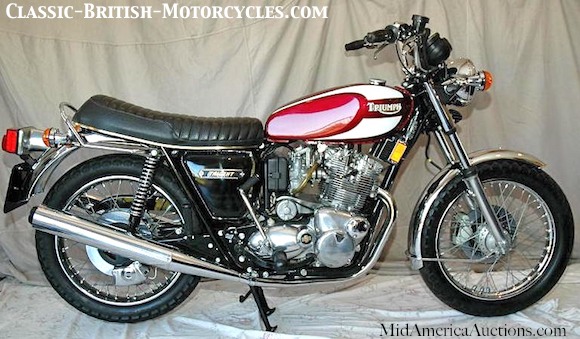
1975 T160 TRIDENT
The1975 Trident was completely redesigned with, of all things, an electric starter! Let the angels rejoice!! The new engine took on the looks of the Rocket 3 with its cylinders slanted forward instead of vertical as before. This was done to make room for the new starter which lived behind it, above the gearbox. Another big change was the switch from right-foot shift (the way God intended) to left-foot shift, a move which also led to replacing the rear conical drum brake with a hydraulic disk similar to the front. All this was draped in stunning new bodywork.
TRIUMPH NAMING CONVENTION
The new bike was dubbed T160 in keeping with Triumph’s nomenclature of naming its highest-performance bikes with a “T” for “Triumph” followed by a theoretical top speed. The reasoning was that if a 650 T110 Tiger was supposed to do 110, then the new twin-carb 650 Bonneville had better be a T120, implying that if a Tiger could do 110, then the new Bonneville surely was good for 120. And when they punched it out to a 750, it only made sense that it should become a T140. 140mph from a 1973 Bonneville? I doubt it. But clearly this new 3-cylinder hot rod must be faster than the old twins, right? So, it was dubbed T150, telling all the world (in Triumph’s own secret code that few understood but them) that the new Trident was a 150mph street bike. Doubtful, but it was had a nice sound to it, nonetheless. So, with this awesome new Trident it only made sense that it must take on an even more ambitious name, T160.
TECHNICAL DETAILS
The Triumph Trident, while a radical new design, was built along very traditional British lines & similar to Triumph twin design. It had vertically-split cases, a one-piece crank with plain bearings, two cams driven by a gear train on the right, with a primary chain on the left. The tappets, tappet blocks, pushrods, rocker arms & spindles were all right out of Triumph’s playbook.
A MISNOMER
Many think, & it is often repeated, that the Triumph Trident 750 triple is ‘a Daytona-and-a-half’, meaning that they based it on the 500 twin & added one more cylinder. This is actually not correct. The bore & stroke on the unit-construction 500s like the Daytona was slightly oversquare at 69mm X 65.5mm. But the Trident’s bore & stroke are slightly undersquare at 67mm X 70mm, which it shares not with the Triumph 500 twin, but with Triumph’s 250 single-cylinder line, the TR25. They supposedly chose the 250 single over the 500 twin because the smaller bore allowed them to keep the engine narrower. Hopwood & Hele actually had a plan to modularize the entire engine line with 500 twins, 750 triples & even a 1000cc 4-cylinder all built from the same basic architecture, but alas it never came to pass.
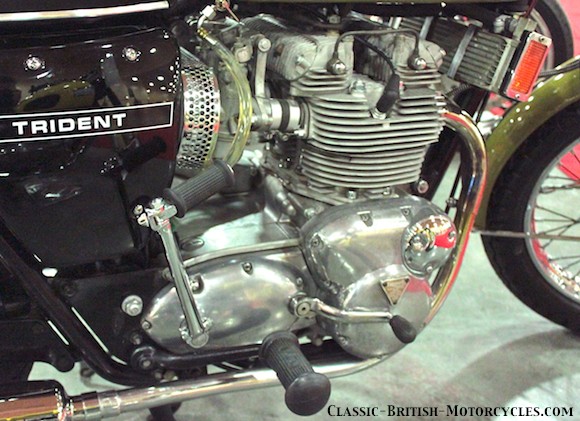
A STOPGAP MEASURE
The Triumph Trident was only meant to be a 5-year stopgap while Triumph prepared a whole new line of modern OHC & DOHC machines at their glitzy new tech center, the infamous Umberslade Hall. So, rather than spend big development money on a whole new design with horizontally-split cases, they sought to keep tooling costs down by utilizing as much of the twin-cylinder engine tooling & techniques. Hence the vertically-split cases, but not two like the twins. The Trident had 3, a center case carrying the 2 center main bearings & two outer cases, each with an end bearing. But they were just part of a complex assembly that included no less than 7 castings & numerous vertical seams which were prone to leaking oil. Built using old tools & old techniques that involved numerous time-consuming processes slowed initial production to just 50 total engines per week at BSA’s Small Heath plant, and this was shared between Triumph & BSA. For instance, it required 56 stages & 48 jigs & fixtures just to machine the center section of the crankcase. Of course, the engines were slightly different, which made them totally different on the assemblyline & even more time was lost switching it back & forth. The crankshaft, on the other hand, was a real work of art. Another advanced product of BSA’s own forge, it was forged in one piece with all 3 throws in line, then heated & twisted until they were set at 120-degrees from each other. Later, when BSA began selling off assets in a vain effort to survive, they sold their metalworking facilities & so later Tridents got conventionally-made forged cranks from an outsource.
IMPRESSIVE MACHINE WITH PROBLEMS
The unique triple-cylinder design was at once new & obsolete at the same time. The ancient pushrod engine architecture dated back to Edward Turner’s seminal Speed Twin of 1938. But, it was still an impressive piece that produced prodigious power & handling. Despite its ancient design, the Trident’s biggest problems usually boiled down to sloppy build-quality from the factory, as this was a time of great upheaval in the BSA empire, which included Triumph. However, when these niggles were sorted out, either by the dealer or the owner, they proved to be very fast, sturdy, dependable machines. Since then, a plethora of parts & techniques have surfaced that go a long way toward solving any problems or shortcomings that the Triumph Trident may have had. Done right, they are perhaps the best classic British motorcycles ever built. And they produce a sound like no other!
RACING SUCCESS
Despite lackluster sales in the showroom, on the racetrack, the Triumph Trident was proving to be a world-class winner. Triumph Tridents won the legendary Isle of Man production TT races from 1971 through 1975, 5 consecutive years, a stunning achievement by any measure. But made even more stunning by the fact that the Japanese were making a major onslaught on all forms of motorsport at that time. Add to that the financial condition of BSA & Triumph as companies, and its amazing that they ever accomplished it.
SAGGING SALES
But despite raging success on the track, Triumph Trident sales never took off. The combination of bad timing (it took too long to introduce), withering competition (the Honda 750-4 had just arrived), homely styling, spotty build quality, low production figures (initially only about 2,500 units per year), and a high price (a 1971 Trident sold for $1,765US, while a ’71 Norton Commando sold for $1,490) doomed the Triumph Trident. In fact, over their 7 model years, the Triumph Trident & BSA Rocket 3’s actually produced totaled only 27,480 machines, combined!
THE POWER & THE GLORY
Despite all the problems & the disappointing sales, the Triumph Trident was one spectacular motorcycle. And it really was the world’s first true multi-cylinder superbike. It was fast, very fast. It won races & achieved great glory for Triumph, BSA and Mother England. And it had to be one of the coolest motorcycles of all time, British or otherwise.
1973 Triumph X-75 HURRICANE
THE 1973 TRIUMPH X75 HURRICANE
As an interesting aside to the Triumph Trident / BSA Rocket 3 story is the X75 Hurricane. Having insisted on a slightly different 3-cylinder motorcycle for their own lineup, BSA wanted to make an impression & show their dealers something exciting for a change, and something that Triumph couldn’t match. There was a lot of interbrand rivalry at that time. They were hoping to come out with what would be called today a ‘halo’ model, one that would get buyers into the showrooms & show the world that BSA still had game. So, they contracted American fairing pioneer, Craig Vetter, father of the Windjammer fairing, to take a BSA Rocket 3 back to his shop & customize it.
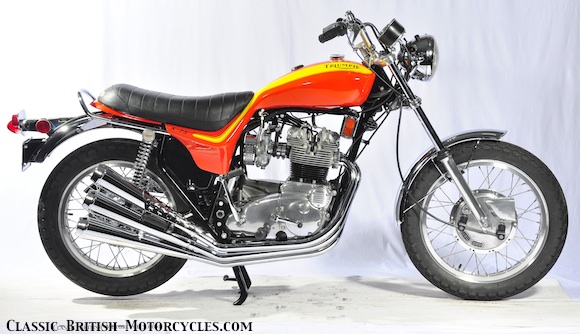
WOW!!!!!!!!!
And what a customizing job he did! He took the stodgy BSA & restyled it completely with a swoopy new one-piece fiberglass tank/seat combo that flowed into an integrated rear fender. The paint scheme was wild: bright orange with a bold yellow stripe. The front forks were extended, per current chopper practice, and most impressive of all, were a wild set of 3 upswept exhaust pipes that ran along the right side of the bike. STUNNING! It all flowed together like nothing anyone had ever seen before. While grossly impractical (with tiny gas tank & extended forks) it had the sex appeal to be a real hit.
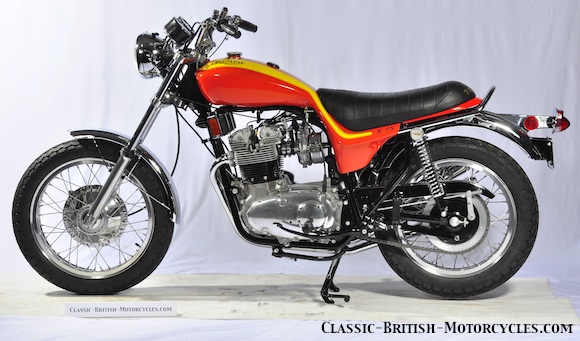
ANOTHER STINK BOMB
But alas, once again, BSA managed to turn a potential hit into yet another dud. BSA’s mounting internal problems, among other things, delayed launch of the A75 Hurricane (BSA nomenclature) so long that when it was finally released, BSA was no longer selling motorcycles, so it had to be rebadged as a Triumph anyway!
IRONY OF IRONIES
So, in the end, the bike that was supposed to ‘one-up’ Triumph actually became a Triumph. But built entirely of BSA parts. The BSA engine, with it’s 12-degree inclined barrels & the twin downtube BSA frame differed greatly from those used on the Trident. But, BSA was now closing its doors and found itself in possession of a huge stock of BSA engines, frames and other parts left over when BSA production was halted. So, in one of their more clever moves, they used the last of these parts to build what was to be the first batch of Hurricanes, under the flag of Triumph. It was a good plan, but too little too late. And a too-high price, once again. And, its most impressive feature, those wild pipes, ended up being the final undoing of the Hurricane, when they couldn’t be made to pass new noise laws in the US. Just 1,152 Triumph Hurricanes were built (1973 model year only), making this not only one of the most exciting Classic British Motorcycles, but also one of the rarest.
Check out our Triumph Hurricane page.
Triumph Trident YEAR-BY-YEAR
1969 TRIUMPH TRIDENT T150
First year for the radical 3-cylinder 750. Unfortunately, it arrived just weeks before Honda‘s game-changing 750 Four, but at first the Trident was faster & always handled better. For 1969, the Trident came dressed in a boxy tank & side covers, and crazy “Ray Gun” mufflers.
1970 TRIUMPH TRIDENT T150
Gone was the boxy styling & “Ray Guns”. The ’70 Trident looked a lot more like a Triumph should, with looks more in line with the Bonneville. Lots of other evolutionary mechanical changes were also made.
1971 TRUMPH TRIDENT T150
Trident gets the same tank, seat, fenders, mufflers, forks, shocks, wheels & brakes as the 1971 Bonneville. That alone is change enough, so few mechanical upgrades were done this year. Perhaps the most distinctive visual feature that sets 1971 & 1972 Tridents apart from all other Tridents is those sexy conical hubs. They look great but don’t stop so good. Oh well.
1972 TRIUMPH TRIDENT T150
Other than its flamboyant purple paint scheme with gold-leaf lettering, the ’72 was carried over from ’71, continuing to share cycle gear with the Bonneville & its sister-bike, the BSA Rocket 3.
1973 TRIUMPH TRIDENT T150
1973 was a very good year for the Trident. It got a front disk brake & 5-speed gearbox, along with lots of refinement. I owned a ’73 myself, and they are my personal favorite.
The wild one-year-only created by Craig Vetter that started out life as a BSA, then ended up a Triumph. Note the slanted barrels, just like the BSA Rocket 3. Sold in small numbers.
1974 TRIUMPH TRIDENT T150
Mostly carried over from 1973, because of the worker strike at Meriden, very few ’74s were built. So, they’ve very rare. Specs are almost spot-on with the ’73, but the tank paint scheme is slightly different.
1975 TRIUMPH TRIDENT T160
The last year of Trident production led to the best Trident ever. It finally got an electric start & left-shift. It looked more like a BSA Rocket 3 with it’s slanted barrels, done to make room for the starter.
Check out these TRIUMPH BOOKS
Triumph Motorcycles: The art of the motorcycle
The Complete Book of Classic and Modern Triumph Motorcycles 1937-Today (Complete Book Series)
Triumph Motorcycles: From Speed-Twin to Bonneville
Triumph Bonneville and TR6 Motorcycle Restoration Guide: 1956-83
British Motorcycles Triumph (Little Books)
Triumph Motorcycles in America
McQueen’s Motorcycles: Racing and Riding with the King of Cool
Triumph Motorcycle Restoration
Illustrated Triumph Motorcycles Buyer’s Guide: From 1945 Through the Latest Models (Illustrated Buyer’s Guide)
Tales of Triumph Motorcycles and the Meriden Factory
Hinckley Triumphs: The First Generation (Crowood Motoclassic)
For more like these, visit our
TRIUMPH BOOK STORE
 |
PLEASE BUY MY NEW E-BOOK HERE 12 Chapters & over 100 original photos. My best work yet. ONLY $4.99! Thank you, Andy Tallone, your humble authorClick here to buy now: The Random History of Classic British Motorcycles, Volume 1 |
Comprehensive Vintage Motorcycle Price Guide 2020-2021






